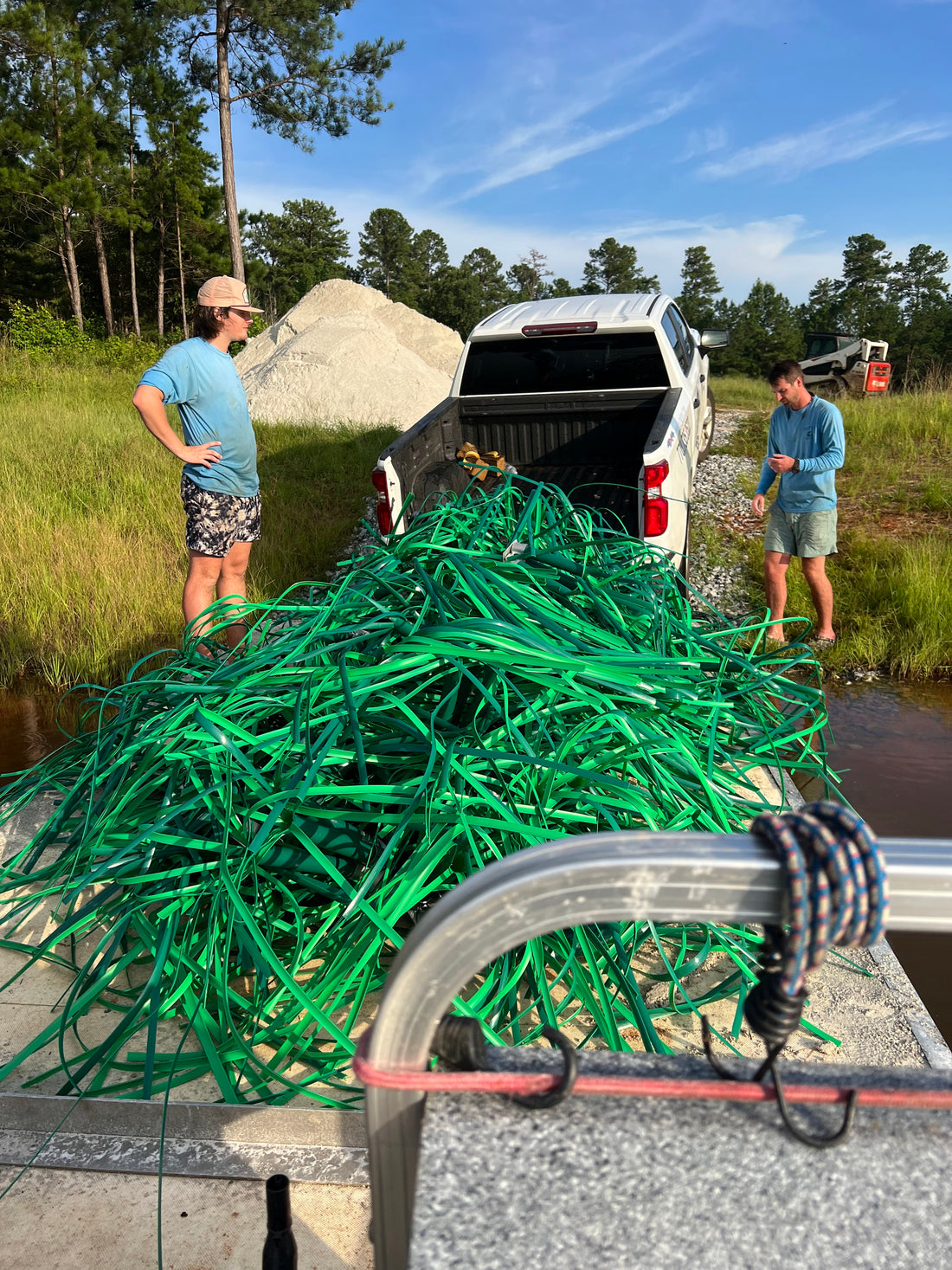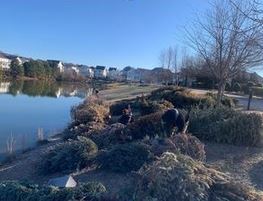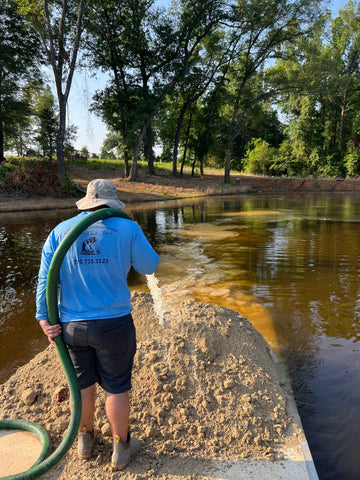
Preparing Your Lake for Winter
Winter Lake Management:
Preparing your lake for winter
The weather is starting to get colder which means it is time to start preparing your lake for winter. The bluegill response to fish feeders is slowing and the bass are starting to be a little tougher to catch. These are a few of the signs to lake owners that the growing season (March- November) is ending. That does not mean it’s time to totally put the rods up and neglect your lake for a few months. In fact, it is a great time to give your lake extra attention. It is just a change of pace in your management plan. Let’s dive into several areas to prepare for during the colder months: winter fish feeding, fish habitat improvements, habitat opportunities, water quality improvements, stocking and inspections.
Winter Fish Feeding
As the growing season wanes, fish activity slows, and they adopt a more lethargic behavior for the next few months. Therefore, this subdued behavior lasts until spring brings back warmer temperatures.
Feeding Bluegill
Furthermore, as water temperatures dip below the 65-degree mark, you can cut back feeding times on feeders as needed. The goal is to dispense just enough food for bluegill to consume within a 5 to 10 minute window. Should surplus food float after this time frame, cut the feeding times back more. As temperatures drop to 55 degrees, a single daily feeding session, lasting only a brief second, usually suffices. Preferably, select the warmer midday hours for feeding. In instances where fish lose interest in feeding altogether, simply empty the feeder, clean it and discontinue feeding until warmer weather is more consistent. Cleaning fish feeders is a great winter time project.
Feeding Cold Water Fish
- You can keep using feeders in the winter for lakes with cold-water fish (e.g., hybrid striped bass, rainbow trout) or fish that remain active on warmer days, such as feed-trained bass and channel catfish.
- Rainbow trout and hybrid striped bass, for instance, consume fish food well in cold months, while feed trained largemouth bass and catfish prefer warmer, sunny days. If you have these fish, feeders can run briefly during warmer times. If the fish eat all the food, increase feeding time until the next cold front.
Fish Habitat Improvements as You Prepare Your Lake for Winter
Throughout the year, bass and bluegill have been busy feeding, spawning, protecting their young, and growing. In the colder months, many of these vital aspects of your fishery start to slow down. One constant element that warrants ongoing attention as you prepare you lake for winter is the habitat. Watch this video to hear more about habitat and its importance Greg Grimes/CEO and Habitat
Whether it's for protection from predators or to sit back and effectively ambush their prey, bass and bluegill are habitually reliant on these aquatic hideaways. Meanwhile, here is a great video with Behind the Scenes of a Habitat Install
Identifying Habitat Opportunities as You Prepare your lake for winter
During the fall and winter months, water clarity tends to be at its peak. Therefore, owners can capitalize on this clarity to locate potential spawning beds and identify barren areas. Any observed deficiencies in habitat can then be addressed by dedicating effort to create fresh habitat zones. Regardless of your lake's size, shape, or age, the addition of habitat remains a necessity. The winter period presents an optimal window for cutting brush or installing artificial habitats to enhance your lake's ecosystem. Watch here for some behind the scenes of an installation Lake Habitat
We offer numerous artificial habitat options and can expertly install them. Additionally, our team can assist in the installation of natural habitats you've collected to enhance your lake. For example, Christmas trees make a great natural habitat for your lake. A great way to thoroughly understand habitat improvement needs is with lake mapping. Lake mapping is the process of creating detailed and accurate representations of the physical characteristics of the lake, such as its depth, shape and bottom topography. This is a service we offer at AES to help clients make the best decisions for their lake's improvement needs.

Count on us for your habitat solutions. In this season, it is an ideal time to assess your lake's habitat and prepare it for the impending colder months.Shop Habitat Options .
Water: Aeration and Water Quality and Winter Lake Management
Water
Part of a winter lake management plan should include the health of your lakes' water. Your lake's water is important year-round, but with the fishery slowing down and the growing season ending, it is also a great time to dive into your lake’s aeration/fountains and water quality. This ensures everything is operating optimally, setting the stage for a successful winter.
Aeration and Preparing your lake for winter
Subsequently, during the fall/winter months, the colder water will be able to maintain higher dissolved oxygen levels as the fish have slower metabolism rates for oxygen consumption in cold water. Thermoclines will dissipate and water will have consistent oxygen and temperatures throughout the water column. This is a great time to have your aeration or fountain systems inspected/serviced.
Aeration Maintenance
Most aeration/fountain systems have routine maintenance that needs to be performed bi-annually to maximize the life of your system. AES can inspect/service your aeration systems which includes services such vacuum out the cabinet, replace/clean your air filters (every 3-6 months), check PSIs, and possibly install a rebuild kit (every 2-3 years). If you have a fountain, AES can remove it from the lake for inspection/servicing. This will give you a chance to make sure that it is cleared and cleaned off to prevent any clogs inside of a motor.
Cleaning Build Up
Organic build up like algae, can coat the motor housing, and this can prevent heat exchange, which can lead to overheating of the unit. This is one major area that can be cleaned off with a power washer. You should also inspect the sacrificial zinc anode to see if it’s time for replacing, ensuring that the anode is not eroding or showing signs of any damage.
Water Quality
Furthermore, as you start preparing your lake for winter, you can have an AES staff member come out to do a water quality consult. AES staff members can help develop a plan to improve any water quality parameters that are falling below a desired measure.
Most importantly, alkalinity is something that all lake owners in the southeast should be checking and managing. Your lake's alkalinity should be above 20 mg/L and a good alkalinity will properly buffer the lake's PH and allow for a successful fertilization program at the start of the next growing season.
Remember, lakes are not fertilized during the winter months.
More on Fertilizing and Liming
However, if you are fertilizing your lake during the warmer months, it is very important to have your alkalinity at proper levels before the next fertilization season. (Get it ready during the colder months) If your alkalinity is not up to par, when you go to fertilization, you will have little success establishing a plankton bloom in the next spring , limiting overall fish productivity. With the poor soils in most of the southeast, lakes need limed every 3-5 years to keep alkalinity levels above 20 mg/L.
Liming the lake will improve the lake's alkalinity. AES utilizes agricultural lime and/or liquid lime to increase the alkalinity. Contact AES today to determine which method is best for improving the alkalinity in your lake.

Phosphorus levels
Testing phosphorus levels during the winter can provide insight into your nutrient status for the upcoming growing season. If your lake experienced excess algae or vegetation growth this year, it could indicate an abundance of phosphorus. For instance, identifying excess phosphorus allows AES to plan for its treatment in the spring, reducing the overgrowth of algae and vegetation.
AES can help develop a strategic mitigation plan based on your specific phosphorus results.
Trout Stocking
Another way to improve or enhance your lake for winter is trout stocking. Trout stocking takes place as the weather cools down in the fall. It is a great time to add an aggressive fish to your lake which is also great table fare. Unlike many fish, trout will be very active throughout the colder months of the year, and can be a great addition to your lake. Therefore, with rainbow trout, you can enjoy catching fish all winter long. These trout can also be stocked throughout the fall for fantastic largemouth bass forage, if you are looking to push your largemouth bass fishery to the next level.
Talk to us about our dam clean up services for your winter lake management needs
Preparing your lake for winter also includes having your dam inspected. Dams should be serviced 1-2 times a year, including small brush and tree removal. With our experienced technicians, we can quickly and efficiently clean your dam area and identify potential issues.
Remember, the dam on your lake is the most crucial part of your lake’s integrity and needs to be inspected routinely. During the cold winter months, most of the vegetation on your dam will be dead allowing AES to perform a thorough dam inspection. Lake owners need to make sure that the dam and outlet system are in good condition and working properly. At AES, we can manage all of your lake’s structural needs.
Conclusion
In conclusion, preparing your lake for the colder months demands a multifaceted approach. As you can see, there are many areas to address as the cold weather approaches. From feeding, habitats and stocking, to water quality and dam/aeration inspections, there are many moving pieces to keep your lake looking its best. At AES, we stand ready to guide you through every step of this crucial process.
Contact us, and let our expertise help you safeguard your fishery during the winter months. Your lake's well-being is our priority.
